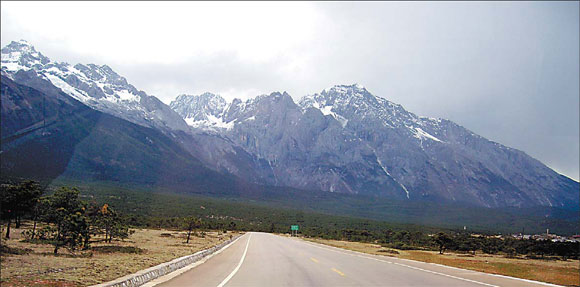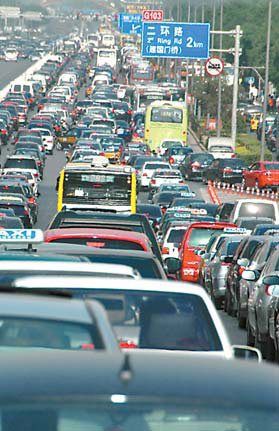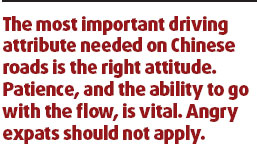|
by Patrick Whiteley
|

Driving on the scenic road outside Lijiang, Yunnan Province, is the reward for expats who get a license. Patrick Whiteley
|
The first taxi ride from the airport to your new Chinese home is exciting, fascinating and charged with hope. A shiny white BMW passes a horse and cart symbolizing China's changing lifestyles. Opportunity permeates everywhere.
As you ponder your new future in the back seat, a black sedan shoots across two lanes, missing your taxi by a whisker. The cabbie does not waver, unlike your heart, which has sunk to the pit of your stomach. Your wide eyes now turn to the chaos on the roads.
There are three marked lanes on the expressway, however, there appears to be four lanes of actual traffic. Many drivers weave in and out of lanes at will and even create their own lane, between lanes. Nobody uses indicators and beeping horns are constant. Without warning, another car cuts in front, and your heart plummets again.
Welcome to China's roads, a network catering for the world's fastest growing motoring market. It is also a road system, on which more than 89,000 people die each year, about 245 people every day, according to government statistics.
Over the past five years, millions of new drivers have joined the motoring throng. In Beijing alone, more than 1,000 new cars are added to the road network daily and inexperienced drivers combined with soaring traffic volumes add to road dangers.
|

Negotiating traffic in Beijing is not as hard as it first appears. Li Bin
|
Despite the risks, many expats are taking up the motoring challenge. One of the major benefits of having a driver's license is the freedom it offers to explore more of this beautiful land. Expat drivers can enjoy taking off on a whim to explore the countryside without relying on a hired driver. It is a wonderful feeling driving past the Great Wall with friends in tow as you venture away for the weekend.
Most expats come from car cultures, and driving is second nature. We first get behind the wheel as teenagers and this on-road experience is very helpful when driving on China's roads. What initially appears to be traffic chaos becomes a system, which can be safely negotiated once it is understood.
To get a license, a potential driver needs to sit a road rules exam. (See breakout). The reference manual costs 150 yuan ($20), however, a license itself costs less than 30 yuan ($4).
The most important driving attribute needed on Chinese roads is the right attitude. Patience, and the ability to go with the flow, is vital. Angry expats should not apply. Drivers will cut in front of you without indicators and warning, and this would normally cause some expat drivers, especially Westerners, to lose their cool. Drop-ins happen so often here, that easily-frustrated types are better off sticking with taxis.
What is surprising is the lack of anger among local drivers. Despite some outrageous driving behavior (sudden U-turns in the middle of a busy highway is just one example), the majority of Chinese drivers have very short memories. I have never seen blinding road rage resulting from near misses, which occurs in the West.
During my experience driving in America and Australia, I have seen drivers chase an "offensive" driver to the next set of traffic lights, get out of their car and punch their foe through the window. This rarely happens here.
The other major driving attribute needed on China's roads is defensive-driving know-how.
Motorcycle riders and truck drivers are more familiar with this mind set than the average car driver. Defensive driving means being acutely aware of the surrounding traffic environment.
Experienced motorcyclists look at their mirrors every three or four seconds, as do truck drivers. They are always scanning ahead 200 to 300 meters, looking for potential danger. They are watching side streets for cyclists, school kids and other traffic. Most car drivers do not operate in such a focused way, but on China roads, especially on country roads, this defensive action is essential for survival.
On a recent drive to Inner Mongolia, I was cruising a lovely stretch of road, which cut through spectacular countryside. The sky was a brilliant blue, cows grazed, and horses galloped over grasslands, as they did back in Genghis Khan's time. A drive like this is the reason why expats get a license. About 300 meters ahead there was a cross road and an overloaded truck was jolting toward the main road.
The driver swerved into my path but I was in no danger. I braked as soon as I saw the blue big rig because I guessed his next move.
Other dangers on rural roads are convoys of trucks and the maddening speeds drivers use to overtake them. The overtaking game is a bit like playing chicken. Don't get caught up in this madness. If a group of drivers are on your tail, let them pass. Don't be pushed into 140km/h speeds. The faster you drive, the less reaction time you have to stop. Create space by slowing down, or when the road is clear, speeding up.
Although we call them road deaths, roads rarely kill people. Drivers do. More than 90 percent of road trauma is caused by human behavior. Speeding is the major killer, causing more than 30 percent of road deaths, followed by driver fatigue and drunk driving.
By expecting the worst and being constantly alert, driving in China, and anywhere, becomes safer. The extra concentration and focus needed on China roads is more draining than back home and fatigue creeps in faster. Make sure you stop, revive and survive every two hours.
It is a good idea to get a map and plan your trip before you head off on a long drive. Thousands of big service stations have mushroomed on China's fast expanding road network, however there is a plethora of small towns, which offer interesting rest stops. This is the real China you don't see in Shanghai, Beijing and Guangzhou.
Talk to Chinese friends to get ideas before the trip. They may know some secret hideaways and can also advise about toll road prices.

City driving, despite the chaos, is not as dangerous as it first looks. The main reason is the lack of speed. My average speed in Beijing on a recent test drive was 18km/h. There is a lot of stop/starting and the slow pace gives drivers plenty of reaction time. There are plenty of gaps in the traffic if you time it right. However, when changing lanes, a driver needs to be aggressive. No matter how much eye contact and smiling there is, people will not let you in, so you have to nudge your way into gaps.
Driving experience comes into play. Many Chinese drivers, despite being aged in their mid 40s, may have only been driving for 5 years. Car ownership is a relatively new experience and some drivers are still becoming familiar with judging space, speed and maneuvering the vehicle. The same-aged expat driver may have 20 more years' driving experience. They can see the gap quicker and safely accelerate because they have done it thousands of times more than the less experienced drivers around them. But don't get cocky. With so many cyclists and pedestrians sharing the roads, it's best to slow down.
A final word of caution: Expat drivers cannot control the actions of other drivers, however they can modify their own.
The author is a former motoring editor for Sydney's Daily Telegraph and also worked for Australian government road safety campaigns.
(China Daily 09/14/2007 page19)
我要看更多专栏文章
|